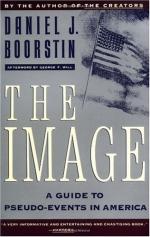
|
| Name: _________________________ | Period: ___________________ |
This test consists of 5 multiple choice questions, 5 short answer questions, and 10 short essay questions.
Multiple Choice Questions
1. Pseudo-events, according to Boorstin, create distortion through what?
(a) Complication.
(b) Falsehood.
(c) Ambiguity.
(d) Propaganda.
2. When did Karl Baedeker die?
(a) 1847.
(b) 1805.
(c) 1905.
(d) 1859.
3. When did Al Capone die?
(a) 1951.
(b) 1949.
(c) 1965.
(d) 1947.
4. Boorstin states that psychological analysis has effectively turned the actions of heroes into compensations for what?
(a) Internal neurosis.
(b) Internal insignificance.
(c) Internal psychopathology.
(d) Internal psychology.
5. The argument is made, in Chapter 3 - Section IV, that the objects in museums were ____ from the homes of the wealthy and famous to be available for all to view.
(a) Hijacked.
(b) Stolen.
(c) Liberated.
(d) Smuggled.
Short Answer Questions
1. What refers to a form of communication that is aimed at influencing the attitude of a community toward some cause or position?
2. In what year did popular publications print articles showing the car was cheaper to operate than the horse?
3. How much were tickets on Thomas Cook's first train tour?
4. When did Thomas Cook conduct his first train tour?
5. Boorstin asserts that the influx of pseudo-events has caused the confusion of participant and what roles?
Short Essay Questions
1. What does Boorstin relate of technology and the sciences in Chapter 2 - Section II?
2. Who was Thomas Cook? What industry did he expand?
3. What comparison does Boorstin make between celebrities and heroes in Chapter 2 - Section IV?
4. What subject does Boorstin address in Chapter 1 - Section V? How have pseudo-events distorted image?
5. What example does Boorstin offer for "the leak" in Chapter 1 - Section IV?
6. How does Boorstin describe pseudo-events in the political arena, in Chapter 1 - Section III? What examples does he offer?
7. How does Boorstin distinguish pseudo-events from propaganda?
8. What aspects does Boorstin describe of pseudo-events in Chapter 1?
9. How did the "Crime of the Century" affect Lindbergh's celebrity?
10. What does Boorstin write of "local atmosphere" in tourist destinations?
|
This section contains 764 words (approx. 3 pages at 300 words per page) |

|




